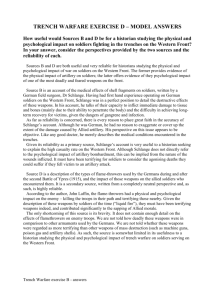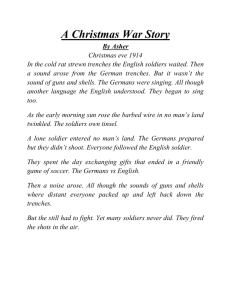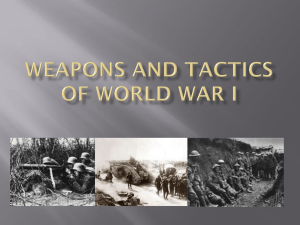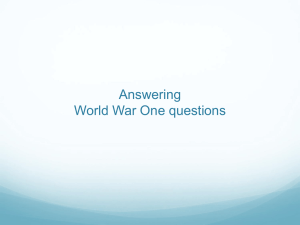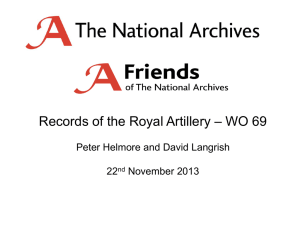trench warfare: source-based exercise
advertisement
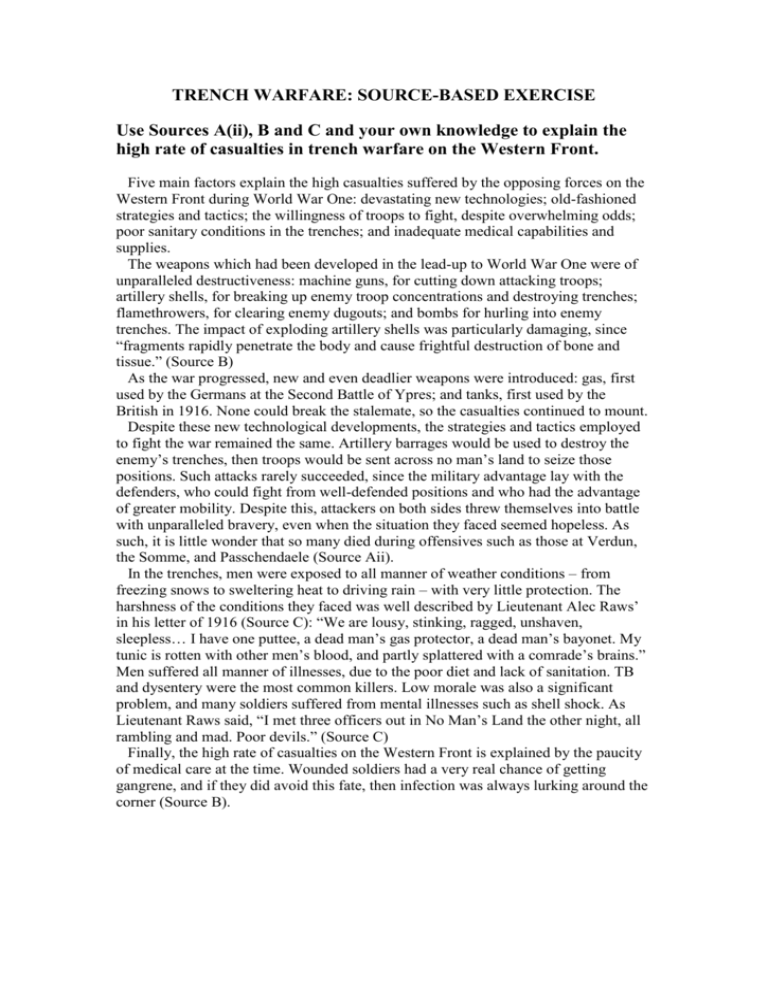
TRENCH WARFARE: SOURCE-BASED EXERCISE Use Sources A(ii), B and C and your own knowledge to explain the high rate of casualties in trench warfare on the Western Front. Five main factors explain the high casualties suffered by the opposing forces on the Western Front during World War One: devastating new technologies; old-fashioned strategies and tactics; the willingness of troops to fight, despite overwhelming odds; poor sanitary conditions in the trenches; and inadequate medical capabilities and supplies. The weapons which had been developed in the lead-up to World War One were of unparalleled destructiveness: machine guns, for cutting down attacking troops; artillery shells, for breaking up enemy troop concentrations and destroying trenches; flamethrowers, for clearing enemy dugouts; and bombs for hurling into enemy trenches. The impact of exploding artillery shells was particularly damaging, since “fragments rapidly penetrate the body and cause frightful destruction of bone and tissue.” (Source B) As the war progressed, new and even deadlier weapons were introduced: gas, first used by the Germans at the Second Battle of Ypres; and tanks, first used by the British in 1916. None could break the stalemate, so the casualties continued to mount. Despite these new technological developments, the strategies and tactics employed to fight the war remained the same. Artillery barrages would be used to destroy the enemy’s trenches, then troops would be sent across no man’s land to seize those positions. Such attacks rarely succeeded, since the military advantage lay with the defenders, who could fight from well-defended positions and who had the advantage of greater mobility. Despite this, attackers on both sides threw themselves into battle with unparalleled bravery, even when the situation they faced seemed hopeless. As such, it is little wonder that so many died during offensives such as those at Verdun, the Somme, and Passchendaele (Source Aii). In the trenches, men were exposed to all manner of weather conditions – from freezing snows to sweltering heat to driving rain – with very little protection. The harshness of the conditions they faced was well described by Lieutenant Alec Raws’ in his letter of 1916 (Source C): “We are lousy, stinking, ragged, unshaven, sleepless… I have one puttee, a dead man’s gas protector, a dead man’s bayonet. My tunic is rotten with other men’s blood, and partly splattered with a comrade’s brains.” Men suffered all manner of illnesses, due to the poor diet and lack of sanitation. TB and dysentery were the most common killers. Low morale was also a significant problem, and many soldiers suffered from mental illnesses such as shell shock. As Lieutenant Raws said, “I met three officers out in No Man’s Land the other night, all rambling and mad. Poor devils.” (Source C) Finally, the high rate of casualties on the Western Front is explained by the paucity of medical care at the time. Wounded soldiers had a very real chance of getting gangrene, and if they did avoid this fate, then infection was always lurking around the corner (Source B). How useful are Sources B and D for an historian studying the physical and psychological impact on soldiers fighting in the trenches on the Western Front? In your answer, consider the perspectives provided by the two sources, and their reliability. Sources B and D are both useful and very reliable for historians studying the physical and psychological impact of war on soldiers on the Western Front. The former provides evidence of the physical impact of artillery on soldiers; the latter offers evidence of they psychological impact of one of the most deadly and feared weapons on the front. Source B is an account of the medical effects of shell fragments on soldiers, written by a German field surgeon, Dr Schlange. Having had first hand experience operating on German soldiers on the Western Front, Schlange was in a perfect position to detail the destructive effects of these weapons. In his account, he talks of their capacity to inflict immediate damage to tissue and bones (mainly due to their ability to penetrate the body) and the difficulty in achieving long-term recovery for victims, given the dangers of gangrene and infection. As far as reliability is concerned, there is every reason to place great faith in the accuracy of Schlange’s account. Although he was German, he had no reason to exaggerate or cover up the extent of the damage caused by Allied artillery. His perspective on this issue appears to be objective. Like any good doctor, he merely describes the medical conditions encountered in the trenches. Given its reliability as a primary source, Schlange’s account is very useful to a historian seeking to explain the high casualty rate on the Western Front. Although Schlange does not directly refer to the psychological impact of artillery bombardment, this can be implied from the nature of the wounds inflicted. It must have been terrifying for soldiers to consider the agonising deaths they could suffer if they fell victim to an artillery attack. Source D is a description of the types of flame-throwers used by the Germans during and after the second Battle of Ypres (1915), and the impact of those weapons on the allied soldiers who encountered them. It is a secondary source, written from a completely neutral perspective and, as such, is highly reliable. According to the author, John Laffin, the flame-throwers had a physical and psychological impact on the enemy – killing the troops in their path and terrifying those nearby. Given the description of these weapons by soldiers of the time (“liquid fire”), they must have been terrifying weapons indeed, and contributed significantly to the sapping of Allied morale. The only shortcoming of this source is its brevity. It does not contain enough detail on the effects of flamethrowers on enemy troops. We are not told how deadly these weapons were in comparison to other armaments used by the Germans. We are not told whether these weapons were regarded as more terrifying than other weapons of mass destruction (such as machine guns, poison gas and artillery shells). As such, the source is somewhat limited in its usefulness to a historian studying the physical and psychological impact of trench warfare on soldiers serving on the Western Front. Assess how useful Sources B and C would be for an historian studying the large number of casualties among officers and infantry on the Western Front. In your answer, consider the perspectives provided by the two sources and their reliability. Five main factors explain the large numbers of casualties suffered by officers and infantry on the Western Front during World War One: devastating new technologies; old-fashioned tactics; poor sanitary conditions; inadequate medical capabilities and supplies; and the willingness of troops to fight, despite overwhelming odds. Sources B and C illustrate one more of these factors, rendering them highly useful to an historian studying this particular topic. Source B is an account by a German doctor, Dr Schlange, who worked in a hospital on the Western Front during the war. As a primary source, its reliability is high. This is particularly so since there is no reason to believe a dedicated surgeon would exaggerate or underplay the conditions he experienced on the front. Schlange describes the effects of shell fragments on soldiers in his care. These devastating weapons caused “frightful destruction of bone and tissue,” making the wounds nigh impossible to treat. If the initial trauma did not lead to death, then there was a good chance that infection or gangrene would, rendering the healer’s task even more difficult. Sadly, there were no antibiotics available at the time, which meant that even the smallest wound could kill. This difficulty was exacerbated by the filthy conditions in the trenches and in no-man’s-land, as described in Source C. Source C is a letter from an Allied Lieutenant – Alec Raws. As a primary source, this document is also likely to be reliable, and even though letters were censored by the authorities to ensure that morale stayed high on the home front, this one is extremely frank, suggesting it contains the truth. In the letter, Raws describes the appalling sanitary conditions experienced by troops in the trenches in 1916. As he puts it, “My tunic is rotten with other men’s blood, and partly splattered with a comrade’s brains.” Given these conditions, it is little wonder that wounds became infected easily and that casualties were high. Raws also tells of soldiers who had been driven mad by the ceaseless bombardment, and who were wandering aimlessly in no-man’s-land – sitting ducks for German snipers and artillerymen. Yet one more reason why casualties were high. Finally, Raws comments on the sheer bravery of the men, who are willing to fight on despite the hopelessness of their situation. As he puts it, “If we live tonight we have to go through tomorrow night – and next week – and next month.” Yet still men did not mutiny or shirk their duties. They preferred to lose their lives rather than lose their honour. Hence it can be seen that both these sources – the one from the perspective of a German surgeon, the other from an Allied officer – are highly reliable, and give significant insight into the reasons why casualties were so high on the Western Front. SOURCE BASED EXERCISE QUESTIONS: 1. Use Sources A(ii), B and C and your own knowledge to explain the high rate of casualties in trench warfare on the Western Front. 2. How useful are Sources B and D for an historian studying the physical and psychological impact on soldiers fighting in the trenches on the Western Front? In your answer, consider the perspectives provided by the two sources, and their reliability. 3. Assess how useful Sources B and C would be for an historian studying the large number of deaths and casualties among officers and infantry on the Western Front? In your answer, consider the perspectives provided by the two sources, and the reliability of each.
